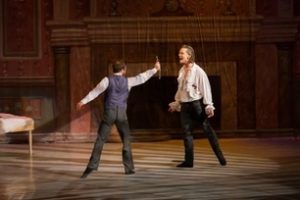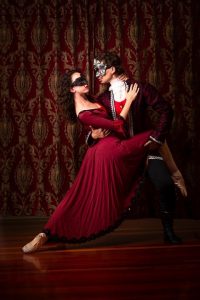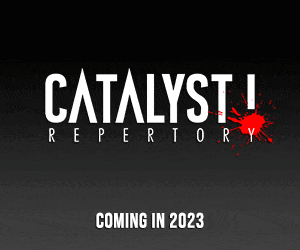
Stirling Matheson – Courtesy of John Crowe. Used with permission.
As a performing arts blogger, one of my favorite topics is arts administration. Currently serving as the managing director of Magic Thread Cabaret and having been in the same role at a community theatre and ballet company, I am deeply familiar with the challenges of operating a performing arts organization. Working in such a capacity, I have also closely collaborated with artistic directors, so I am quite familiar with the responsibilities that come with that role as well. As a result, I am highly interested in those who operate behind the scenes to present their artistic products on the stage.
During the past few months, several well-respected colleagues suggested that I interview Stirling Matheson, artistic director of Ballet Theatre of Indiana. Of course, I was familiar with the company, but have not yet seen it perform. But based on rave reviews given by those who recommended I speak with Matheson, I look forward to seeing a concert this coming season. In the meantime, I reached out to Matheson and he graciously agreed to meet with me.
A California native, Matheson, 31, attended Butler University where he earned a B.A. in Dance (Pedagogy) in 2009. While at Butler, he performed in principal roles in “Giselle,” “Cinderella, “Serenade” and other works. After graduation, he danced with Ballet Theatre of Maryland, where he performed solo and principal roles in “Alice in Wonderland,” “The Nutcracker,” “Romeo & Juliet” and “Frontier: The War of 1812.” After leaving Maryland, he worked as a guest artist throughout the country before co-founding Ballet Theatre of Indiana with his wife, Sabrina in 2014.
A number of original works created by Matheson for BTI include “Dracula, The Masque of the Red Death,” “Baby Yaga,” and “Under the Bridge.” He also directed the short film of Sarah Farnsley’s “Absolution,” which premiered at the TCL Chinese Theatre in Hollywood as part of the Dances With Films festival and has been featured at several other festivals as well.
Also a writer, Matheson has been published by Dance Magazine, Digital Trends, Complex Magazine, 95 Octane, and About.com.
Recently, I sat down with the refreshingly outspoken Matheson at a Fishers coffee shop to talk about BTI and his work. Following is an edited transcript of our conversation and later an email correspondence.
Why are you a dancer?

Stirling Matheson as Albrecht in “Giselle” 2018 – Courtesy of Mark Abarca. Used with permission.
The short and facetious answer is that when I was eight, my mom asked if I’d like to take a dance class and I said, “Sure.” The more truthful answer is that the motivation has changed over the years. Teen-aged Stirling was motivated more by a drive for athletic excellence, but as I got older, I realized that the real magic of ballet is the ability to profoundly tell emotionally rich stories or explore emotionally rich themes. Dance, when compared to other performing arts, can only portray simple plot lines, but can portray rich emotional content in an entirely unique way.
Tell me about how Ballet Theatre of Indiana was conceived.
I was freelancing in Indianapolis and writing at the time. Sabrina, my wife, and I had been watching City Ballet of Indianapolis and waiting to see if it would turn into a company. Ron Morgan of the Performer’s Edge offered us empty studio space during the day and since we were tired of waiting, we decided to do it ourselves. In a grass-roots manner, we put together a company, put on a few shows and it has grown quite a bit since then. We just wrapped up our 5th season.
What is BTI’s mission?
It’s not just to present ballet and create a new foundation for ballet in Central Indiana, but also to make it accessible. We know we could make more money on events if we raised our ticket prices, but I want more people to come for a low ticket price than a handful come for a high ticket price. Tickets are $25 across the board.
How would you describe the brand of Ballet Theatre of Indiana?
Classically based, but sometimes, gleefully unorthodox. The basis of ballet is undeniably brilliant, but like all art forms, it needs to evolve. Many ballet companies and choreographers are so afraid of being literal and it’s a huge turn off to a lot of people. Don’t vaguely hint at elements of your story; show them. Likewise, many contemporary ballets are abstract to the point of being undecipherable. One of BTI’s guiding artistic principles is that every step should be motivated. Every piece says something meaningful.
What is your annual budget?
This last year about $125,000. One thing we joke about is we provide more ballet per dollar than anybody else.
How much of your budget goes to artists?
Thirty to 40 percent goes to production expenses and the rest goes to paying the artists.
What else informed your decision to form your own company?
Part of our philosophy was derived from looking at ballet companies where we saw not only terrible mistreatment of dancers, but huge amounts of waste. There was one company that had four events a year and five full-time marketing staff. And everyone there was making $55 to $80,000 a year. Five people to market four shows, which is asinine. Also during the last 20 years, there has been a rise in the college-educated dancer and a lot of those dancers are getting two degrees. We focused on dancers coming straight out of college, who didn’t just want to languish in the corps and wanted to not only get a chance to dance a bit, but also use their other skills. A perfect example is Audrey Robson, who was one of our company members. She had degrees in both dance and communications from Butler. Those were both things we needed. We needed a dancer and we needed someone writing press releases and helping market our shows. So, we found one person who could do both and that has been a constant in our recruiting the whole time.
When you refer to “dancer mistreatment,” can you be more specific?
A lot of it has to do with dancer pay, which is awful. And then a lot of companies, besides not paying a livable wage, they want 40, 50, 60 hours a week out of dancers. That means these people are getting second jobs and only getting five or six hours of sleep a night. I’ve done it. I have done the 9:30 to 5:00 rehearsal. And the 6:00 to 12:30 restaurant shift. And then I go home and eat and that happens six days a week. That’s just not sustainable and creates injuries. It is just not ethical.
What is the rationale for higher administrative salaries in ballet?
You need a marketing person, but you don’t need five people to market four shows. There is only one thing you need to put on an evening of dance. I have seen great ones that didn’t need costumes. I have seen great evenings of dance that were weird, site-specific or didn’t even have theatres or sets. You just need dancers. That’s kind of step one. And they are always the last consideration. I feel like a lot of dancers are stunted in their growth when they get into companies because it changes from a situation in which they are supposed to be trained, to a situation in which they are just expected to do a job. That’s natural and unavoidable. But a lot of directors seem to try their best to keep dancers in this place that is between a valued professional and a student. There is this ruling by fear that’s very pervasive and an abuse cycle in ballet that’s really toxic. It’s amoral and frankly, while it is an easier leadership method, although it’s simple, it’s not as effective as the actual leadership. You can get a lot more from dancers who produce much better work when they are comfortable.
What are your criteria for choosing dancers?
The first one is they need to be able to dance. A simple level of technical proficiency is required, but our choreography is often very athletic. I want to see people really attack the movement. Tentative dancers don’t do well in our company.
Are you the primary choreographer?
Yes. There is also Cole Companion, who has done a lot of our ballets. He is our resident choreographer. He’s a good friend of mine. He was at Butler at the same time I was for a brief time, but he ended up having to transfer. He is a wildly creative choreographer. He always comes up with something literally no one else would have thought of.
What do you enjoy most about choreographing?
Saying something. My ballets, while often story-driven, always have something to say beyond the plot. “Under the Bridge” on the surface, was a story of a group of people struggling with addiction and mostly, not making it out. But the real point was that these were all valuable human beings who were effectively self-medicating and trying to treat their own problems without the use of any kind of support network.
Is your work a mix of classic and contemporary?
Yes.
What are you presenting next season?
We are bringing back our “Dracula,” which I am very excited about. I am comfortable saying that was our best show.
Tell me about it.

Stirling Matheson as Dracula in “Dracula” 2017 – Courtesy of Marc Arbaca. Used with permission.
I choreographed most of it, but there were a couple of scenes that were done by Cole. It’s set to the Philip Feeney score, which is just fantastic. Our production is very true to the novel and it’s very theatrical. We decided to do that story justice. Many ballet companies are afraid to be genuinely violent or genuinely sexual and it is so abstracted that the sensation of it is dulled to the audience. So, we decided we were going to eschew that sort of unspoken tradition of ballet. It’s not going to be somebody gets gingerly poked with a sword and then stumbles around the stage musically for a while. Bram Stoker wasn’t terribly subtle about the obvious symbolism of Dracula and Mina swapping fluids. “Dracula,” on the surface, is a fairly faithful retelling of the Bram Stoker novel, but we’ve accentuated a theme of what really makes him monstrous: his humanity. The worst things about Dracula aren’t that he’s a walking corpse or that he drinks blood, but that he’s a murderer and a sexual predator who uses his power and wealth to inflict his will on everyone around him. He’s horrifying not because he’s a fantasy monster, but because he’s a very real kind of monster.
Where does BTI perform?
We’ve done most of our shows at the Athenaeum. It’s a really cool venue. There’s nothing else like it. We will be moving some of our shows next year. There are always some gremlins at the Athenaeum. What first brought us there is we have a partnership with Sun King Brewery. We do “Beer & Ballet” every year, which is a contemporary mixed bill served with beer. We went to the Athenaeum because there is a place for people to put their beer down. Next season, we’ll present “Dracula” and our “Three Fairy Tale One-Acts” at The Tarkington at the Center for the Performing Arts in Carmel.
What else in in your season?
The obligatory “Nutcracker.” Seven shows of it. It is bloody exhausting. This year, we did some updates to try to keep the narrative going through the whole show. As I mentioned, one of our guiding philosophies is that every one of our steps should be motivated. If I get a choreography proposal that says, “This piece is my interpretation of the music as movement,” that is a strong no, right off the bat. What we put on our stage doesn’t necessarily need to tell a story, but it needs to say something other than, “Here are pretty people wiggling for seven minutes.” One of my issues with the “Nutcracker” is the narrative of it is basically over halfway through the first act. So, we did some updates. We turned Clara from a small child into more of an adolescent, making the transition from girl to woman. We created a narrative of her developing a relationship with Drosselmeyer’s nephew and the Nutcracker Prince. We’re going to expand that a lot more this year and I am looking forward to that. Nothing has changed with the order or score or anything, but we use the scenes differently.
Another thing I am trying to do this year is make the Spanish Dance, Arabian Dance, and Chinese Dance more relevant to the plot line. I’m not sure how I am going to do it yet, but will. I am particularly proud of my Chinese Dance. When we created our first “Nutcracker,” years ago now, one of my pet peeves is just how overtly racist the Chinese Dance is in most versions. The Balanchine one is particularly egregious in the older productions, although the NYC Ballet changed it this year. I was one of the earlier signers of the “Final Bow for Yellowface” pledge drafted by a man named by Phil Chan, who was trying to eliminate that stereotype in ballet. When I first heard about it, I had already done it. When we staged it, I did a great deal of research into Chinese opera and ended up fusing together a lot of the elements of the Water Sleeve Dance. I made it into something that is genuinely Chinese and still ballet and actually reflective of the culture it’s supposed to be portraying, rather than a 19th century European interpretation of it.

Stirling Matheson as Prince Prospero in “Masque of the Red Death” 2015 – Courtesy of John Crowe. Used with permission.
What do you say to those who rationalize they are just presenting dances, such as the Chinese Dance, as simply period pieces?
We don’t even know what the original ballets looked like. The classics have been molded and reworked and modified by every company that’s put them on stage and for every dancer that has been in those roles. “Nutcracker” is a lot of kids’ first introduction to ballet and one thing I remember Phil Chan talking about at a “Final Bow for Yellowface” pledge event was that for a lot of Asian kids, they are really getting into the show until this big nasty stereotype in this hideous makeup comes running out of the wings. It’s a gut punch to these kids, who up until that point, are falling in love with a new art form, until they are exposed to that. I think accessibility is a big issue for ballet and we should be modifying our ballet.
You appear to have political sensibilities.
Absolutely. As an artist, you are supposed to have some political sensibilities.
Are you active in politics?
Not terribly. I vote. As an artist, you need to have something to say. I have always been interested in philosophy. That has always been part of it. We like to view politics as if it is not related to the rest of our lives, but it is. People literally live or die based on political decisions. So pretending politics is separate, that it is a hobby, is irresponsible.
Tell me more about “Beer and Ballet?”
The whole thing is going to have a jazz theme and I am really excited about it, partially because I love jazz, and partially because Indianapolis has such an amazing history of jazz. My grandmother actually owned a jazz club in Broad Ripple in the 50s called Dori’s Place. She’s an incredible pianist. She played for Frank Sinatra for a while.
So I presume you are familiar with Indy’s jazz tradition.
I am. I really didn’t know anything about Indianapolis before I came to Butler, beyond the jazz scene that I heard from my grandmother. The fact that my grandmother lived here and I went to Butler was a happy coincidence. She lived here once upon a time and then moved to California once she had kids. She lived with us for a long time when I was growing up in California. So I would hear all these jazz standards floating up from the stairway from her basement apartment.
For those who love ballet and have not seen your company, why should they see your shows?
Our shows are designed to make you feel something. Ballet’s strength is the ability to show emotional content in a raw and unique way, and we try to capitalize on that whenever possible.
For those who have never or seen very little of ballet, why should they attend?
Ballet has a reputation for being an obtuse club for the elites and unfortunately, many directors, by petting their own egos, have cultivated that. If the audience doesn’t understand the ballet, that is the fault of the choreographer. Yes, there will be things that a balletomane will understand better than a first-time audience member, but our audiences will never leave feeling like they just sat through two hours of inside jokes they weren’t in on. Through exciting and accessible programming, we’ve grown a new audience for ballet.
For more information about Ballet Theatre of Indianapolis visit www. btindiana.org







